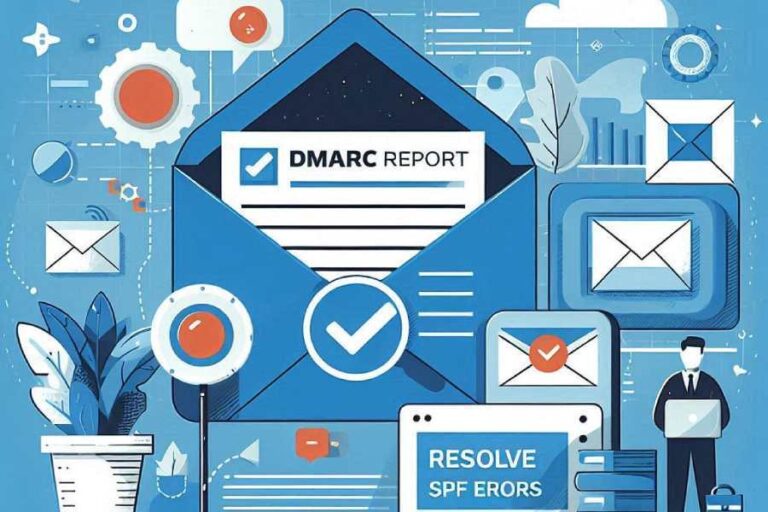In the world of email communication, getting your messages to land in inboxes instead of spam folders is crucial. This is where Sender Policy Framework (SPF) records come into play. They act as a security measure, helping email providers determine if the emails sent from your domain are legitimate or potentially harmful.
If you’re wondering why your carefully crafted emails aren’t reaching their destinations as intended, understanding and checking your SPF record could be the missing piece of the puzzle. Follow along as we explore how to use MXToolbox—a reliable tool that simplifies this process—so you can ensure your emails are not just seen but also welcomed in your recipients’ inboxes.
To check your SPF record using MXToolbox, simply visit their website and enter your domain name in the SPF Record Lookup tool. This will provide you with detailed results regarding your SPF record’s syntax, potential issues, and compliance with best practices to ensure optimal email deliverability.
What is an SPF Record?
An SPF (Sender Policy Framework) record serves as a crucial line of defense in the realm of email communication, functioning as an email validation protocol. This record operates within the DNS (Domain Name System) by explicitly defining which mail servers are authorized to send emails on behalf of your domain. By doing so, it significantly reduces the risk of spam and phishing attempts, where misleading emails often masquerade as legitimate correspondence.
Mechanics of SPF Records
The SPF record itself is published as a TXT entry in your domain’s DNS settings. This means that when an email is sent claiming to come from your domain, the recipient’s server will consult the SPF record to validate the sender’s authenticity. For example, a simple SPF record may look something like this:
v=spf1 include:_spf.google.com ~allIn this case, it clearly informs the receiving server that emails originating from Google’s email servers are legitimate for your domain. If an email comes from a server not indicated in this record, it might be flagged as suspicious or even marked as spam.

Understanding SPF records isn’t just about knowing their structure; it involves recognizing their role in improving email deliverability rates across different businesses.
Importance of Email Deliverability
With all this in mind, it’s easy to see how integral these records are for businesses aiming to maintain effective communication with their audience.
Properly configured SPF records can lead to substantial improvements in email deliverability rates. According to findings from Email on Acid in 2023, domains with well-structured SPF records experienced a remarkable 25% increase in delivery success compared to those lacking such configurations. This statistic underlines the importance of ensuring that your SPF record is correctly set up and maintained.
Regularly checking and updating your SPF records is essential, particularly if your organization utilizes multiple email service providers or undergoes changes in its mailing strategies. Failing to do so can result in discrepancies that lead to communication breakdowns.
Crafting and maintaining an effective SPF record requires attention to detail and continuous review. As you guide your organization through setting up this crucial framework, remember that having a single SPF record meant to encompass all authorized sending services—while eliminating any conflicting entries—is key to optimizing your email strategies.
Understanding the mechanics and significance of SPF records prepares us to examine tools that streamline the management and verification processes, ensuring smoother communication across all platforms.
How MxToolbox Enhances Email Validation
MxToolbox has earned its reputation as an indispensable ally for managing email-related issues due to its suite of powerful tools designed for that purpose. One core functionality is the SPF record lookup tool, which swiftly verifies your SPF configurations. This ensures your records are not only present but also compliant with best practices and the Internet Engineering Task Force’s RFC 7208 standards—a prerequisite for effectively delivering emails.
When you think about how critical email authentication is in preventing malicious spoofing attempts, having this capability at your fingertips is invaluable.

But MxToolbox goes beyond simply checking if an SPF record exists; it identifies potential issues within those records. For instance, it can highlight syntax errors or pinpoint overly complex configurations that may negatively impact your email deliverability rates.
Imagine crafting a well-thought-out marketing email—only to find it landing in spam folders because an SPF record problem went unnoticed. With MxToolbox’s tools, preventative checks can save you from unnecessary headaches down the line. Effective maintenance of SPF compliance increases your likelihood of landing in inboxes rather than spam folders and protects your sender reputation.
Users frequently report marked improvements in their email deliverability after employing MxToolbox for validation tasks. There’s a notable drop in spam complaints and email bounces once users have validated their SPF configurations. This demonstrates how crucial this service can be for organizations aiming to enhance their email communications.
This emphasis on proactive management facilitates a more seamless user experience, further establishing trust with recipients.
Utilizing MxToolbox can help ensure that your emails are delivered correctly, allowing you to focus on what truly matters: engaging with your audience. By taking advantage of its comprehensive checks, you can rest assured knowing that your SPF records are functioning optimally while reducing the risk of being misclassified as spam and promoting higher engagement levels.
As we navigate through these enhancements, it’s essential to explore the practical steps involved in leveraging this powerful tool effectively.
Steps to Use MxToolbox for SPF Check
Using MxToolbox to check your SPF record is a straightforward process. First, head over to the MxToolbox website. Once there, you’ll find a plethora of tools designed to help improve your email operations, but our focus today is on the SPF Record Lookup tool. This tool is incredibly user-friendly and allows anyone—regardless of technical expertise—to perform necessary checks in minutes.
Upon landing on the site, look for the search bar. Here, you’ll need to input your domain name. For example, if your domain is “example.com”, simply type it into the search bar. After entering your domain, click on the ‘SPF Record Lookup‘ button nearby. This action will prompt MxToolbox to dig deep into its database and pull up your specific SPF record.

It’s like having a dedicated assistant who checks the health of your email system!
Once MxToolbox generates the results, you’ll be presented with your SPF record alongside a comprehensive analysis. This visual representation not only shows whether your SPF record is valid or has issues but also highlights it using color-coded indicators. A green highlight signifies all is well, while red warns you of potential errors or omissions that need attention.
- Understanding Results: Make sure to take a moment to comprehend what the results signify. You may see details about authorized sending servers and flagged entries that could impact deliverability.
- Next Steps: If there are any issues indicated, consider taking action based on the recommendations provided by MxToolbox to resolve them swiftly.
If you’re serious about maintaining and streamlining management of your SPF records, consider hosting them directly with MxToolbox. Doing so makes future edits simpler since you won’t have to access your DNS settings each time you want to make changes.
By following these simple steps, you empower yourself to keep your domain properly secured and authorized for email communication. In this ever-evolving digital landscape, being proactive with tools like MxToolbox can protect both your reputation and functionality as an email sender.
Now that you’ve learned how to effectively check your SPF records, it’s important to understand what those results mean and how they can impact your email communications.
Reading and Interpreting Results
Once your results are displayed on MXToolbox, you’ll notice a mix of colors and tags that together paint a picture of how well your domain’s SPF records are set up. The visual representation provided by MXToolbox is particularly user-friendly; green checks indicate that everything is functioning as it should be, giving you a sense of reassurance. However, if you’re met with red crosses or yellow warnings, it’s time to dive deeper.
Key elements to focus on in your SPF record include the version tag, various mechanisms listed under it, and the qualifier at the end. For instance, starting with the “v=spf1” tag is essential as it indicates you’re using the first version of the SPF protocol—if this isn’t present, you may need to create a new SPF record entirely.

Next comes the use of include mechanisms which authorize external mail services like Google Workspace or Microsoft 365 to send emails on behalf of your domain.
It’s also vital to pay attention to the ending qualifier—this can be either ~all or -all. The -all signifies a hard fail for any unauthorized sender trying to use your domain; if their SPF record does not match up, their email will be rejected at the server level. On the other hand, ~all represents a soft fail; unauthorized emails still go through but are marked as suspicious. This distinction forms a cornerstone of your email authentication strategy.
| Element | Explanation |
| v=spf1 | Version protocol |
| include | Authorizes external services |
| -all | Hard fail for unauthorized |
| ~all | Soft fail for unauthorized |
After identifying these elements, take a moment to assess whether they align with your email sending practices. If your company uses multiple email platforms or third-party services for newsletters or notifications, ensure that their addresses are included in your SPF settings with appropriate mechanisms. This will not only make sure they’re authorized but also help prevent them from being flagged as spam by recipients’ servers.
As you work towards enhancing your email security through proper interpretation of your SPF records, it’s crucial to understand how to tackle potential issues that may arise. Addressing these components effectively is key to ensuring reliable email communication.
Fixing SPF Record Issues
One of the most common issues encountered when checking an SPF record is incorrect syntax. This misstep can render your entire record invalid. For instance, imagine typing a phone number without spaces; the numbers lose their meaning and purpose. Similarly, ensure that your SPF record has proper spacing between directives and uses the correct sequence. Take your time to meticulously rewrite the record, as accuracy here is essential for successful email authentication.
Another prevalent issue arises from exceeding the maximum allowable DNS lookups in an SPF record. With a limit set at 10 DNS queries, attempting to make more calls can trigger ‘permerror’ – a frustrating roadblock. To address this effectively, consider consolidating multiple include mechanisms into fewer entries. By combining IP addresses and correctly utilizing subnets, you create a streamlined SPF record that stays within permissible limits while still ensuring your emails are authentic.
Now, let’s take a moment to reflect on how multiple SPF records can create havoc for authentication checks. If your domain harbors several SPF records, they may clash during these checks, causing unnecessary confusion for mail servers trying to verify your legitimacy. The solution? Merge all your SPF entries into one cohesive statement. This not only simplifies things but also enhances clarity in how emails are authenticated.
Don’t forget that wildcards can be a double-edged sword—while they allow for flexibility, they can also open the door for unauthorized senders to send emails on behalf of your domain. Avoid using ‘*’ for authorization; instead, clearly define the elements that are permitted to send messages.

Lastly, be vigilant about your DNS configuration. Any overlooked or incorrectly set DNS settings could risk the functionality of your email services altogether. Regular monitoring of these changes and employing reliable DNS management tools can safeguard you against potential mishaps.
With these considerations in mind, you are on track towards enhancing your email validation strategy—next, we will explore techniques that further refine your configuration for optimal results.
Optimizing Your SPF Configuration
To truly maximize the effectiveness of your SPF records, think strategically about how you structure them. It’s not just about listing IPs; it involves clearly defining who is authorized to send emails on your behalf while complying with the DNS lookup constraints. At its core, optimization enhances both the security and deliverability of your email communications.
One simple yet powerful rule to remember when crafting your SPF record is to keep it under the 255-character limit for TXT records. This limit ensures that your SPF record functions properly and can be read quickly by receiving servers. Consistency in size also prevents unnecessary complications during validation.
When utilizing the include mechanism, be judicious. Only include essential email services necessary for your operations, as unnecessary or outdated entries can lead to misconfigurations. For instance, if you’ve transitioned away from an old service provider, remove it from your SPF entry to improve reliability and maintain compliance with best practices.
Consider this: for domains that send emails from multiple sources—be it marketing platforms like Mailgun or internal servers—an optimized SPF record may resemble something like this:
v=spf1 include:_spf.google.com include:mailgun.org include:servers.mydomain.com -allThis format succinctly states which mail services are authorized while ensuring clarity in execution. Think of it as creating a well-organized to-do list; when items are clearly marked and ordered, each task (or mail server) can carry out its work effectively without overlap or confusion.
Therefore, having a streamlined SPF record enhances email deliverability rates and significantly reduces the chances of legitimate emails being sent astray or marked as spam.
As you tweak and refine your SPF record entries, don’t forget to conduct regular audits with reliable tools like MXToolbox. Constant monitoring ensures these configurations align with your evolving email needs and allows you to catch potential issues before they escalate into significant problems.
Engaging in this habit fosters a proactive approach toward your email security strategy.In summary, optimizing your SPF configuration is crucial not only for protecting against unauthorized senders but also for maintaining a smooth communication flow via email. Stay diligent and monitor configurations regularly to achieve the best results.






